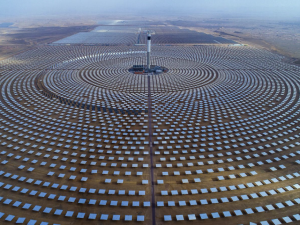This guest blog comes from Mason Cole, MA Politics and Contemporary History student and Sustainability Champion Assistant (SCA), supporting the King’s Energy Team.
We’ve all wondered if it’s possible to cover the Sahara Desert in giant solar panels to resolve our renewable energy issue. No doubt you will have seen utopian constructions of what this could look like. For instance, David Attenborough’s A Life on our Planet provided an example of how a future powered by renewable energy could look. But in Morocco, that future is already here, and they’ve taken that interest in Sahara solar panels seriously too. Check out this image of the world’s largest concentrated solar power project, the Noor Ouarzazate Solar Complex:
When was it built?
Construction began in May 2013. There have since been two expansion productions also commissioned, one in 2018 and one in 2019. It was funded by the Moroccan Agency for Sustainable Energy at the cost of a cool $3.9 billion, though this funding came from several investors, including the World Bank.
How does it work?
Here’s the cool part! Noor I uses Concentrating Solar Power (CSP) to produce energy. Essentially, this means that a series of mirrors divert sunlight into something that retains that energy to be used later. The unique part about Noor I is that it uses molten salt to store energy, meaning that energy collected during the day can also be released at night.
The complex has upgraded on this for Noor II and III, which can store energy for up to 8 hours. Noor II uses a slightly different technology: parabolic troughs, or concave mirrors to the rest of us, to reflect the sun’s rays. Noor III, meanwhile, has a solar tower that collects the energy reflected from the mirrors (pictured).
Finally, Noor IV, which has not yet been commissioned, will use photovoltaic panels as we know them, so we will be one step closer to finding out what will happen if we fill the world’s hottest places with solar panels.
How much energy does it produce?
Noor I alone produces 370GwH per annum, with Noor II producing 600GwH and Noor III 500GwH and combined, they cover 6,178 acres. To put that into context, global energy usage was 171,240TwH in 2019. It would seem then that Noor is just a drop in the ocean, but consider that the Sahara Desert is 2.273 billion acres. It would take 116.5 Noor’s to supply the world with renewable energy based on 2019 demand, which would require 719,674 acres of the Sahara… Now, that really is just a grain of sand.
A couple drawbacks and limitations include the need to regularly clean the solar panels (even more so because of the sandy environment), which requires large amounts of water and the challenge of transporting power over great distances and political will.
As always, if you have any further questions or want to get involved with King’s Energy, get in touch!


